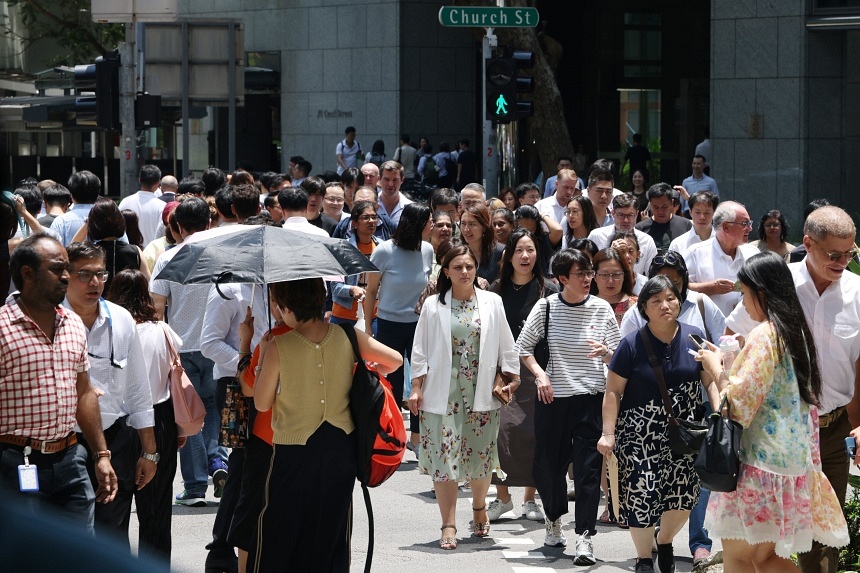
MAS added that employers’ financial conditions appear to have strengthened in recent quarters, which could lead to a pickup in job creation. SINGAPORE – Singapore workers could see better real wage growth in 2025 amid an expected uptick in labour productivity growth and easing inflation, said the Monetary Authority of Singapore (MAS) on Oct 28. But nominal pay raises, which do not take inflation into account, could be smaller, after already slowing down in the first half of 2024.
Even as hiring is expected to remain robust, MAS also cautioned in its twice-yearly macroeconomic review that some groups of workers may be having greater difficulty securing employment that matches their skills. It highlighted retrenched professionals, managers, executives and technicians (PMETs), as well as older workers, as having lower rates of re-entry into employment than the pre-Covid-19 average. Just 53.
2 per cent of PMETs were back in work in the second quarter of 2024 within six months of being retrenched, down from the average re-entry rate of 62.6 per cent between 2015 and 2019. For workers aged 50 and above, the rate was 41.
6 per cent in the second quarter of 2024, down from the 55 per cent average over the same period. The mismatch between available jobs and skill levels or expectations of workers may also lead to a risk of workers being underemployed, MAS said. This is happening against the backdrop of a less tight labour market with less churn, with employers more willing to retain workers while workers are more cautious about leaving.
Nonetheless, MAS added that employers’ financial conditions appear to have strengthened in recent quarters, which could lead to a pickup in job creation. Employers’ gross operating surplus growth turned around in the first half of 2024 after four consecutive quarters of negative growth in 2023, it said. “The firming economic activity should thus provide some impetus to labour demand and put a floor to any weakness in the labour market.
” However, it also noted that the boost to labour demand from the growth upturn is unlikely to be large. “Following aggressive hiring and some labour hoarding over the past two years, firms likely have some capacity within their existing workforce to accommodate stronger demand without a large step-up in hiring. “In addition, the recent pickup in GDP growth has been largely driven by the capital-intensive electronics manufacturing sector, which would not impact labour demand significantly.
” Meanwhile, moderating labour demand in the first half of 2024 compared with 2023 pushed down nominal wage growth, which does not account for inflation, to 4.1 per cent in the second quarter of 2024, from an “unexpectedly high” 6.4 per cent a quarter before.
MAS said the percentage of sectors with nominal wage growth exceeding pre-Covid-19 averages has fallen steadily from its peak of 97.7 per cent in the second quarter of 2023 to 56.2 per cent for the same quarter in 2024.
“Growth in nominal average monthly earnings should continue to moderate in the quarters ahead, reflecting in part the high base effects from large bonuses paid in Q1 this year.” Still, wage growth could be firmer in sectors with high job vacancies such as health and social services, as well as those covered by the progressive wage model (PWM), such as food and beverage, retail trade, and administrative and support services. The PWM is a wage ladder tied to skill and productivity improvements currently in place for lower-wage workers in seven sectors and two occupations, with wage floors at each rung that are increased according to a pre-determined schedule.
MAS also said labour productivity growth is expected to recover discernibly in 2024 and pick up further next year, which will be led by cyclical improvements in the trade-related cluster, which includes industries such as manufacturing. Output per worker in the services sectors could also improve as firms are able to use more of their capacity and make investments into capital-intensive equipment such as automation. “Overall, improved productivity growth alongside easing nominal wage growth should help bring down overall unit labour cost growth, while helping to secure sustainable real wage gains for workers,” MAS said.
The easing of inflation is set to provide more headroom for real wage growth. Core inflation eased from 3 per cent in the second quarter of 2024 to 2.7 per cent year on year in the third quarter of 2024.
Meanwhile, headline inflation fell from 2.8 per cent to 2.2 per cent over the same period.
Excluding the impact of the Goods and Services Tax hikes over the past two years, core inflation - which excludes private transport and accommodation costs to better reflect the expenses of households - is estimated to have slowed to 2 per cent in the third quarter, the lowest reading since the fourth quarter of 2021. In 2025, both core and headline inflation are expected to average 1.5 per cent to 2.
5 per cent, said MAS. Join ST's Telegram channel and get the latest breaking news delivered to you. Read 3 articles and stand to win rewards Spin the wheel now.














